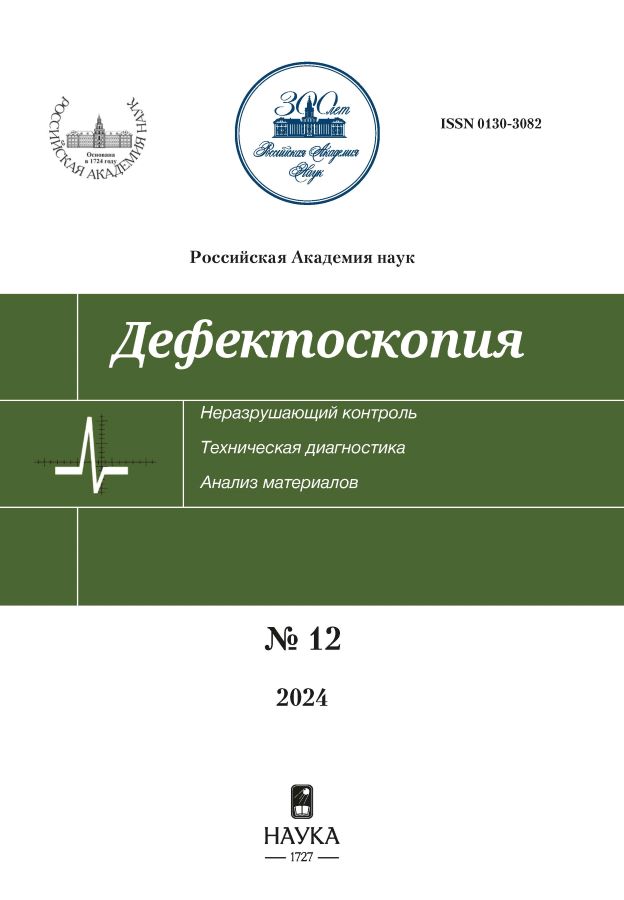№ 12 (2024)
Акустические методы
Особенности построения планарной локации источников акустической эмиссии с помощью триангуляционного алгоритма Inglada
Аннотация
Разработке методики повышения эффективности обнаружения источников акустической эмиссии (АЭ) при планарной локации с применением алгоритма Inglada посвящена эта работа. Рассмотрены основные факторы, влияющие на погрешность определения координат источников АЭ при планарной локации с применением стандартной методики. К ним относится пороговый способ определения момента регистрации сигнала преобразователями АЭ по превышению фронтом нарастающей волны напряжения порога дискриминации (uth), уровень частоты дискретизации сигналов (fd), влияние дисперсионных свойств среды на процесс затухания амплитуды импульсов и скорость их распространения. С целью уменьшения влияния перечисленных выше факторов на результаты координатной локации источников АЭ предложена новая методика, основанная на применении корреляционных зависимостей скорости распространения импульсов АЭ в зависимости от амплитуды регистрируемых сигналов и учета задержки момента регистрации импульсов ПАЭ при пороговом способе их фиксации. С целью реализации предложенной методики проведена серия предварительных испытаний, в ходе которых с помощью электронного имитатора выполнялась генерация импульсов АЭ с уровнем максимальной амплитуды um = 45—90 дБ. При этом положение источника излучения импульсов АЭ варьировали в диапазоне от 150 до 700 мм относительно приемных преобразователей антенной решетки. В результате применения разработанной методики вероятность обнаружения источников АЭ повысилась до p = 0,71, тогда как при стандартном подходе она не превышала p = 0,36.
 3-13
3-13


Применение технологий CF и DMAS для повышения качества изображения отражателей, восстановленного по эхосигналам, измеренным антенной решеткой
Аннотация
Достоверность и чувствительность ультразвукового контроля определяется уровнем шума изображения отражателей и его разрешающей способностью. Применение CF- или DMAS-технологий в различных сочетаниях перспективно, так как эти технологии достаточно простые, практически не требуют дополнительных вычислительных ресурсов, применяются к эхосигналам, измеренным обычными дефектоскопами, работающими с антенными решетками. В численных и модельных экспериментах продемонстрировано, что применение этих методов позволяет повысить разрешающую способность изображения отражателей более чем в два раза и уменьшить уровень шума более чем на 20 дБ. В численном эксперименте показано, что фазовые искажения из-за комплексных коэффициентов преломления и отражения приводят к тому, что даже при точно известных параметрах опыта при работе на прямом луче на поперечной волне индикация вершины трещины может сместиться от своего истинного положения примерно на длину волны. Для решения задач дефектометрии это очень большая ошибка. Но если при восстановлении изображения отражателей проводить коррекцию фазы, то индикация вершины трещины совпадает со своим реальным положением. CF- и DMAS-технологии показали свою работоспособность и при работе с зашумленными эхосигналами.
 14-29
14-29


Применение импульсного газоразрядного электроакустического преобразователя для задач дефектоскопии
Аннотация
Представлены результаты исследования газоразрядного электроакустического преобразователя, функционирующего на основе импульсного разряда в воздухе при атмосферном давлении. Рассмотрено влияние конфигурации электродной системы на акустические характеристики преобразователя. Показано, что изменение объема разрядной камеры и межэлектродного зазора преобразователя оказывают значительное влияние на интенсивность излучения. Выявлены особенности, возникающие при использовании электроакустических преобразователей открытого и закрытого типов в задачах дефектоскопии. Показано, что газоразрядный электроакустический преобразователь открытого типа является достаточно мощным широкополосным источником сигнала возбуждения и имеет перспективы применения в неразрушающем контроле. Газоразрядный электроакустический преобразователь закрытого типа имеет преимущества при исследовании изделий с особыми требованиями к чистоте поверхности или величине прикладываемого внешнего электрического поля.
 30-43
30-43


Влияние плотности листов терморасширенного графита на прохождение акустической волны
Аннотация
Приведены результаты экспериментальных и теоретических исследований влияния поверхностной плотности тонкого пористого листа терморасширенного графита на коэффициент прозрачности для акустической волны. Доказана возможность применения теории тонких пленок для описания процессов прохождения акустических волн через пористые листовые среды в области низких частот и малых толщин. Проведена оценка влияния рабочей частоты на чувствительность коэффициента прозрачности к поверхностной плотности листа.
 44-58
44-58


Рентгеновские методы
Повышение эффективности идентификации изображений дефектов при компьютерной расшифровке цифровых радиографических изображений сварных соединений опасных производственных объектов
Аннотация
Повышению эффективности идентификации изображений дефектов при компьютерной расшифровке радиографических изображений посвящена эта статья. В работе рассматривается задача сегментации изображений дефектов, а также модели сегментации изображений дефектов на радиографическом снимке как при ручной, так и компьютерной расшифровке. Показано отличие алгоритмов поиска и идентификации групп, скоплений, цепочек пор, шлаковых и металлических включений от ручной расшифровки снимков.
Разработаны и экспериментально проверены на АПК КАРС алгоритмы поиска и идентификации дефектов для применения в комплексах цифровой радиографии. Сходимость результатов компьютерной и ручной расшифровки составила 0,85.
 59-68
59-68


Электромагнитные методы
Оценка напряженно-деформированного состояния трубопроводов по результатам измерения магнитных характеристик в полевых условиях
Аннотация
Проведена серия измерений на двух участках трубопровода из стали 17Г1С с помощью двух измерительных приборов: магнитный мультитестер ММТ-3 и магнитный структуроскоп КРМ-Ц-К2М. Получены карты распределения коэрцитивной силы, остаточной магнитной индукции и максимальной магнитной индукции по трубам. Рассчитан коэффициент нагруженности для разных поперечных сечений трубопровода. Построены графики зависимости усредненных по поперечному сечению магнитных характеристик от коэффициента нагруженности. Выявлено, что наиболее опасным для разрушения сечениям, в которых коэффициент нагруженности превысил критическое значение 1,2, соответствуют пониженные значения коэрцитивной силы и остаточной магнитной индукции, полученные при направлении измерения вдоль оси трубопровода. Показано, что измерение вдоль оси на верхней части трубопровода, т.е. на 12 ч, показывает аналогичную зависимость, как и для усредненных по сечению значений, а это означает, что в наземных переходах трубопровода может быть достаточным измерение только на 12 ч.
 69-80
69-80













